In this brief we share some initial insights into the migration of video traffic from traditional channels into what can best be described as an emerging Video Internet Ecosystem
Two ecosystems have evolved to delivery video to consumers: the Hollywood system, based on over one hundred years of evolution, and the Video Internet System, based on only ten years of evolution. These ecosystems are mostly parallel but in some places interconnect, clash, converge and rapidly evolve. One thing in common to both is that innovations are fundamentally changing the viewer experience. We will compare these two systems at a high level, highlight how they work and highlight some potential trajectories..
Sometimes it is helpful to create a model, a simplified abstraction of a real world system, to better understand the fundamental mechanics of an ecosystem. Let's start with a model of the Hollywood Movie Creation-Production-Distribution Process and see how it interacts with the emerging Video Internet System.
There are three main parts of the Hollywood System: Creation/Production, Distribution and Consumption.

Figure 1 - Hollywood and Video Internet Creation, Production and Distribution Models Idea Creation.
The movie typically starts with an idea that gets conceptualized, refined, destroyed, reborn, and recreated many times until it resembles a screenplay that can be submitted to the studios, usually through an agent .
While the creative process may be difficult, the marketing and sale of the idea and screenplay may be more difficult due to the sheer volume of people who wish to see their idea turned into a released movie by the movie studios. For those screenplays that are accepted, the writer gets paid in a variety of different ways, and typically for the exclusive rights to all aspects of the idea (film, merchandising, etc.).
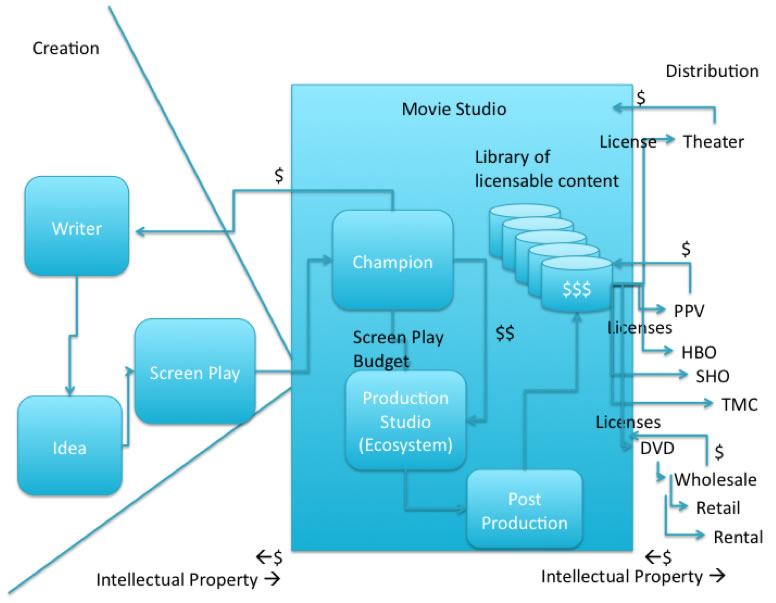
Figure 2 - Hollywood Creation and Production Model
Movie Studio. The Movie Studio does extensive market research to determine what people will pay to watch . This scrutiny is applied to all screenplays received and reviewed.
Production Studio. After the screenplay goes through pre-production, budgeting, marketing analysis, etc. and if the studio decides to make the movie ("green-lighting it") a production company is contracted to make the film with within a budget and schedule. The application of money transforms the script into a digitized that the Movie Studio adds to its catalog of licensable content . The output from this activity is a large uncompressed video file, from 40GB to 1TB in size. From this master, a mezzanine compressed version is used to make the different streaming bit rate versions and the DVDs for physical players.
Model Input and Output: So at a high level, the studio pays for the intellectual property (a screenplay), transforms it into a new piece of intellectual property (digital movie) with an increased value based on its potential future earnings.
Over one hundred years of experience has led to a profit maximization formula, a combination of marketing and staged distribution across channels as discussed next.
Probably the biggest value add form the Movie Studio is the expertise in marketing, promoting, and licensing of the movie to those who will ultimately distribute the movies to the eyeballs. This is a high stakes process .
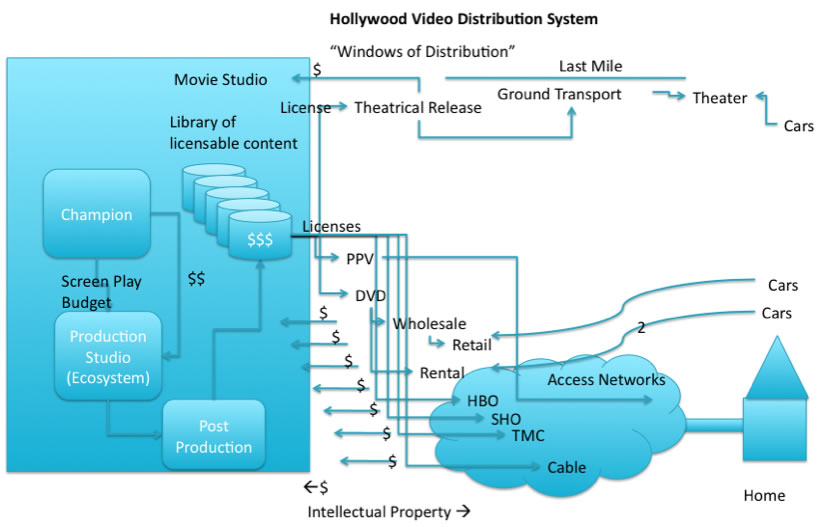
Figure 3 - Hollywood distribution Model
Movie studios sell the license for the distribution along these channels under specific terms and conditions in return for license fees.
This is a tightly controlled "Windows of Distribution" system that staggers the releases over time to each distribution channel in a manner that has historically proven to maximize profits. This is the dominant path the the home entertainment market – only 3% today use the Internet download and related services .
The marketing budget for the movie is expended to maximize the success for the theatrical release , and hopefully provide it with enough carry over enthusiasm to continue its popularity into the Home Entertainment (aka 'ancillary') market. The windows of distribution typically follow a schedule like this:
Licensing terms are negotiated across each distribution channel for inclusion of the movie into their rotation of licensed movies for the end customers. The DVDs are produced using a contracted manufacturer after the movie is released to the theaters . They are released to the retail sales and rental markets that yield up to 80% margin. Merchandising is typically accomplished by selling the license to manufacture with terms including veto power.
As the movie gains popularity and critical acclaim, the value of the product increases, the studios can command more money for the license to distribute to cable channels and commercial television, and thus the portfolio of the studio assets increases.
Model Inputs and Outputs : The intellectual property (movie) and the licenses are sent through the distribution channels in exchange for license fees. License fees take different forms for each channel: a percentage of the box office receipts, a cut of the rental and retail sales, a cut of the physical (DVDs) or on-line download sales, etc.
There is money made along the supply chain – it is a well established healthy ecosystem in that every participants plays a role and makes benefits from participation in the ecosystem.
The power position of Hollywood Movie Studios comes from three places
At each stage of the way, the value of the product increases.
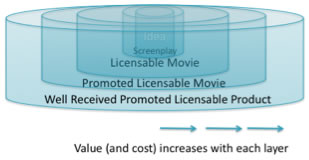
Once the video is distributed over the last mile, the content is available in the house in digital form, available for time shifting, potential capture and re-distribution, as we will discuss next.
The are essentially two markets for displaying movies: the Theaters and the Home Entertainment markets.
"There are currently two types of projectors for digital cinema. Early DLP projectors, which were deployed primarily in the U.S., used limited 1280×1024 resolution or the equivalent of 1.3 MP (megapixels). They are still widely used for pre-show advertising but not usually for feature presentations. The DCI specification for digital projectors calls for two levels of playback to be supported: 2K (2048×1080) or 2.2 MP at 24 or 48 frames per second, and 4K (4096×2160) or 8.85 MP at 24 frames per second. " "In March 2009 AMC Theatres announced that it closed on a $315 million deal with Sony to replace all of its movie projectors with 4k digital projectors starting in the second quarter of 2009 and completing in 2012.[7] "
Movies are delivered to the home as digitally encoded DVDs or across a traditional cable company, telco, or satellite access network that increasingly provide multiple services (Video, Voice, Internet) over the same physical plant conceptualized in the diagram below.
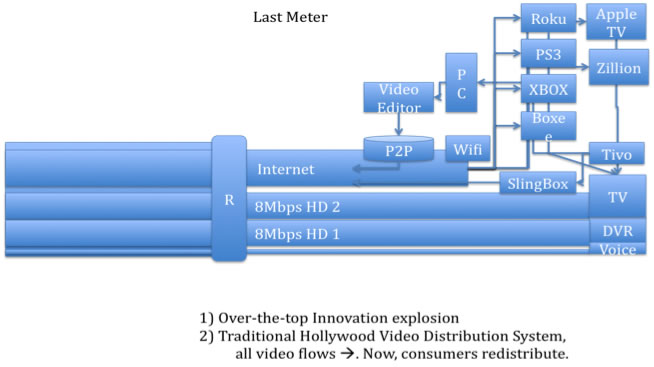
We will now explore a variety of "mini-revolutions" that enabled the Video Internet.
Mini Revolution #1 is the last mile Internet bandwidth. With DOCSIS 3 and VDSL deployed in the AT&T Uverse product, consumers have 25-50Mbps of Internet capacity to their homes. This supports an increasingly wide range of innovated Internet-based (often termed 'over-the-top') home entertainment products. It is interesting that these over-the-top services compete with the relatively static video and voice feed products the access networks provide to the consumers.
Mini-Revolution #2 is 802.11n wifi in the home and wifi-enabled consumer electronics. This provides Internet access for a wide range of home products which now offer additional services if the consumer has Internet access.
For example,
A) Skype is a widget bundled in with Panasonic and LG TVs, allowing video conferencing in the living room.
B) BluRay DVD players, PS3 and Xbox 360 gaming consoles, as well as purpose-built Roku and Boxee and some TVs have wifi and Netflix and related widgets built in allowing Netflix video on demand using those services.
C) Internet content – Philips TV is a product that allows channel surfing side by side with streams of sequenced Internet video content. These video applications would not be possible without high capacity home wifi and sufficient bandwidth through the broadband pipe into the home.
Mini-Revolution #3 is Tivo, or more generically time shifting. Time shifting has led the consumers to the expectation that they should be able to watch what they want when they want it and be able to skip over commercials. Future generations will likely say "I can't believe you let someone else dictate what you were allowed to watch and at what time. Time Shifting reset customer expectations to a model more conducive to the bi-directional interactive viewing experience of the Video Internet over the traditional one-way flow that has evolved and hardened in the Hollywood system. This is the first step towards the video internet interactive TV and away from the traditional channel surfing video consumption model.
Mini-Revolution #4 – Big Screen TVs with built in wifi and support for widgets for applications. This is both a blessing and a curse for the Video Internet; large screens don't look good unless they are displaying HD content, and the commodity best-effort Internet may not be well suited today to deliver a consistently reliable stream of HD content to make these big screens look good. Netflix streaming for example is rumored to be primarily standard definition. Trajectory – video conferencing and high-resolution gaming will use result in a massive increase in the on-demand real-time (non-cachable) video distribution to and from the home. This will lead to the need for massive infrastructure in the last mile. One way this could grow is with massive deployments (tens of thousands) of in-town CDN nodes and in-town exchange points. Trajectory – What does it mean to have your Skype TV hacked? Blackmail from the hacker that turned on the camera and recorded your life. Trajectory – Apple iTablet will become a ultra-portable TV display, capable of receiving whatever channels you bought with your broadband television subscription. Essentially, the iTablet turns into a cell phone with a really big display. This smart portable agent could evesdrop on your conversations and bring up appropriate content to your table side. A comment such as "Did you see that consulting sidekick site?" and up comes the site automatically. Implication – massive wireless BW consumption and service redirection will emerge as part of the offering. Intersecting Ecosystems - online video rentals (AppleTV, Zillion, Hulu, etc) are an emerging part of the Video Internet Ecosystem, and a direct analog to the cable PPV VoD service for watching missed episodes of shows you already paid to receive but missed and failed to capture for some reason. Trajectory – Licensing will change so you pay for access to the content – as long as it streamed to your house at the time, you can access it anywhere anytime.
Mini-Revolution #5– Ease of video portability. Once in the home, it is easy to capture the video on your Tivo or PC, transfer it to your mac using Tvio transfer, and save it to your laptop of iphone making the video portable. With the SlingBox product the author sends the video from his cable box or dvr over the Internet to his laptop so he can watch television shows in his native language while in Japan. The Ritz Carlton in Tokyo has an interface from your pc to the in room HDTV so you can watch these American shows in your hotel bedroom. Without explicit Hollywood or the cable company permission, these applications in effect created a video redistribution system. Mini-evolution #6 - Peer-to-Peer. The more disconcerting (to Hollywood) revolution is redistribution by file sharing. Enthusiasts, receiving no compensation, capture movies and television programs, edit out the commercials, and redistribute the content over the peer-to-peer networks. We interviewed a bunch of these folks to find out how they did it, and more importantly, why they did it. After all, it takes time, expertise, specialized software, and they provide quality edited digital content without compensation, and if caught, they could face jail time.
The Peer-to-Peer video capture culture is a little like the software cracker community in the 80's and 90's; there is a sense of pride in a quality job, and a branding win for the one who provides a high quality distribution first.
Video: Good Copy Bad Copy (58:00) - Movie about sampling, Copyright, MPAA, Pirate Bay
They get the movies and television shows from:
Encoding:
1) transferred to a PC running pirated (sometimes pro ) editing and encoding software.
Distribution:
Upload a torrent file and seed until enough people obtain all the pieces to be self-sustaining swarm
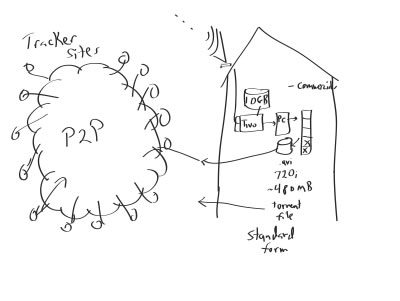
When I researched "The Emerging Video Internet Ecosystem" I focused some of the time on understanding piracy, mostly because peer-to-peer was such a large consumer of bandwidth. Also, the distribution of the video content was predominantly peer-to-peer. A couple years back I spoke with some of the folks who captured the TV shows on the east coast, ripped out the commercials, and propagated the re-edited versions of the show to the 'net. Some of these guys did movies as well. I asked them why they did it since there was a bit of work here, a potential penalty if caught, and they received no financial compensation for this work.
Here are the top 8 reasons they gave for piracy
Video: Piracy is Good? (8:53) - Presentation about an new entertainment revenue flow paradigm
The first response to the file sharing community followed the failed path that the recording industry took – to sue their fans for redistributing their content. As expected, this approach created the bad press and alienated a lot of folks.
Hollywood Ecosystem responds to P2P piracy with change in process
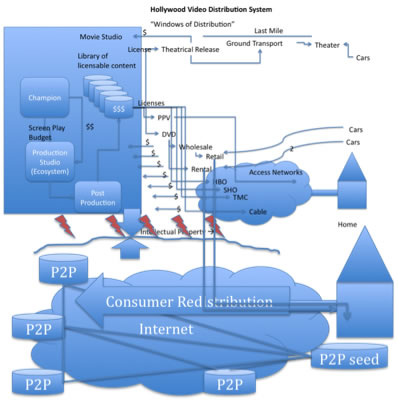
In response to the Video Internet peer-2-peer redistribution, the movie studios have morphed their processes to overcome the criticisms described above. The movie studios have
Is this enough to combat piracy and increase revenue from the Video Internet?
But the Video Internet is more than just peer-2-peer redistribution and renting/buying Hollywood video product over the Internet – it has activated the latent creative forces of a generation through several more mini-revolutions enabling the Video Internet Content-Production-Distribution systems.
Up until 2005, distributing video across the Internet was costly and difficult. Broadband access networks were not widely deployed. The bandwidth available from the video content to the consumer eyeballs was low , variable and sporadic. The cost for distribution of video was high ($270 in 1998 ).
As a result, video distribution across the Internet was largely the province of technically savvy users spending days or at least hours to download pirated movies and television shows from Usenet news feeds. At the end of these hours to days to download and what you got may not be what you expected (early camera captures of movies in captured in theaters). We view the Video Internet as not enabled at this stage since it was very low quality and difficult to use .
Between 2000 and 2005 there were a set of mini-revolutions and innovations that enabled, in fact opened up the floodgates of an emerging Video Internet Ecosystem .
The consumer video recording market has been alive and well for decades, but there were several challenges for the amateur. Video equipment was expensive, too complicated to operate for many novices, and the captured content was difficult to manipulate, duplicate, and almost impossible to distribute.
Mini Revolution #1 – cheap and easy-to-use cameras and video editing software. In the 2000-2005 timeframe, the price of digital video-capable cameras down to the point where the masses could finally afford them (<$200) and simple enough (one-button shoot) for anyone to operate. Around the same time, Apple released updated versions of iLife ($79), which included iMovie for editing and encoding video into a variety of formats.
All of a sudden, digital video capture enabled the masses to capture and tell their story like the shows they saw on TV and in the movies! If only they could distribute them to their friends, families, and the world!
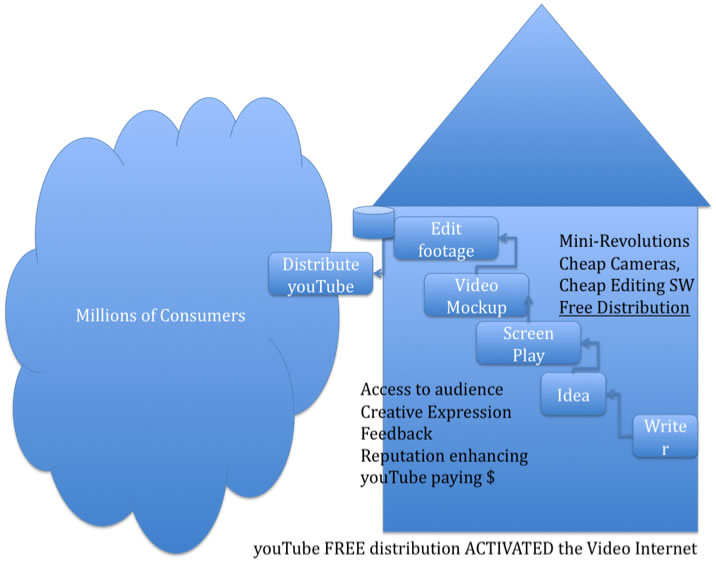
Mini Revolution #2 – free video distribution. The Video Internet Ecosystem was activated the day the youTube service launched and provided simple and free distribution of short videos across the Internet. In the period of a year or so, it was cheap and easy to capture high definition video, edit it into something resembling video people would want to watch, and distribute it to a potential audience of millions for free! Where Hollywood was the only way to reach masses with video content, all of a sudden, youTube provided an outlet for creative video content to a market of millions of eyeballs.
Every minute about 20 hours of online video are added / uploaded to the youTube catalog .
One could argue that youTube has helped accelerate the Video Internet by growing the market for consumer video creation/production goods:
1) camera SD cards being made with wifi to automate distribution across the net
2) iPhone 3Gs to have video camera on it
3) video editing software to be enhanced to automate uploading to youTube
4) Internet shows specializing in identifying "hot" or viral video – The Digg Reel for example
5) A large number of competitive video aggregation portals
The barrier to entry for the non-casual filmmaker lowered as well…
Mini Revolution #3 – cheap pro video gear. Indie Film productions have access to the same professional studio camera technology for less than $10,000 that used to be hundreds of thousands of dollars. A now larger market for movie making equipment (lighting, audio systems, prompters, etc.) drove down the costs for those unable to get into the Hollywood system. Armed with an idea and professional equipment, scrappy creative types have the capability of producing feature length compelling movies .
Apple made Final Cut Pro available to the aspiring filmmaker for around $1200 as well, the same software many major motion picture editors use for feature films!
Ultra-Portable filming equipment is marketed to those who wish to quickly set up and take down a remote shoot, which helps the amateur to avoid the timely and costly public location permitting process.
By keeping the movie budget under $5M, independent production houses in Hollywood are not required to be a union shop, further decreasing the cost of production in Hollywood .
To complete the Video Internet Ecosystem, youTube and other portals have started to offer revenue shares with those video producers that generate 1 million hits or more . While this doesn't make a lot of money for very many independent movie makers, this is an emerging trend that makes the Video Internet production systems look a lot more like the Hollywood Creation and Production System but without the gatekeepers and power asymmetries.
Parallel – the two production systems are largely parallel in the sense that the idea (brain waves) are transformed into a script (paper) and then into video (bits) distributed to the masses.
Intersecting – Hollywood is trying to pull ideas from the broader population activated by the Video Internet – see the "We are the Strange" story in CrowdSourcing. Hollywood is using the Video Internet as a channel for on-line movie sales and rentals, as well as for an exploration of alternatives to commercial-sponsored television on demand (aka Hulu).
Differences - Today, the barrier to entry for releasing video into the wild has been reduced to zero and the quality of the millions of clips released across the Video Internet is highly variable, difficult to search and consume.
Chaos – not a lot of chaos has been generated by the existence of these two models.
Frictions include copyright protection issues between the two ecosystem: people uploading copyrighted material to source it on youTube. By the time the copyright holder informs the portal, thousands of views have already occurred. With video mashups, the very notion and form of copyright in the digital age is up for question .
Frictions are increasing as folks are implementing auto-takedowns when copyrighted material is identified by recognition software without thought to fair-use and exceptions clauses in the U.S. copyright law.
Evolutions – While Hollywood is evolving to produce only blockbuster movies, the video Internet is growing with a broader scope:
Innovations can be expected to emerge. For example, there is frustration with finding quality in the haystack of poor content. Generic semantic and social network systems may count the number of global views and references, ratings and search systems, producer rankings, etc. to separate the wheat from the chaff.
Philips TV has emerged as an integration platform combining commercial TV with sequenced youTube and other Internet channel content. Expect to see continuations along the theme of aggregation and integration across these two production systems.
Now let's model how the digital video is distributed using the Hollywood System and across the emerging Video Internet Ecosystem.
We will model youTube as Hollywood Studio (rights holder and distributor) analog, so let's compare how youTube uses the Video Internet Ecosystem to distribute the massive volume of short video to the eyeballs.
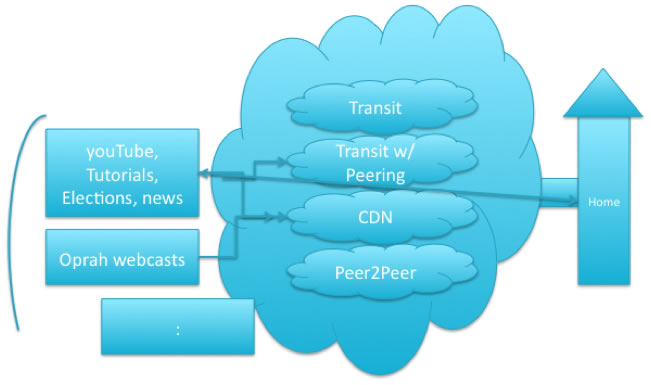
Mini-Revolution - youTube is the created with activating the Video Internet because it not only made it free and easy for the end users to upload video, but it also addressed the difficult and expensive video distribution and social networking (build an audience) issues. Prior to youTube, there was no practical way for common users to distribute their video content over the Internet.
However, it is important to note that youTube itself could not have succeeded without being able to deal with the difficulty and cost of video distribution issues.
Mini-revolution – Adobe Video encoder. This and other software made it easy for youTube and others to automate uploading and encoding of video into easily distributable Flash Video format (FLV), which requires the end-user browser Flash plug-in to display flash content. Perhaps not as a revolution but certainly as an enabler, the encoding and plug-in software was a necessary prerequisite for the youTube service to function.
Mini Revolution – Decreasing distribution fees. The cost of Internet traffic distribution plummeted in the 1998-2008 timeframe from $1200/Mbps to $2-$9/Mbps. If it wasn't for this drop, youTube may not have been able to ramp up the social network of videos and eyeballs, nor would it have survived; at the time youTube was acquired by Google, it was rumored to be spending around $1M/month on Internet transit fees, even with that much lower priced transit.
During its time as a private company, youTube made use of several of these different subsystems for distributing its videos to the eyeballs.
Refer to the "Video Internet : The Next Wave of Massive Disruption to the U.S. Peering Ecosystem" to see the modeling and costing of Internet Transit, Peering, Content Delivery Networks, and Peer-2-Peer video distribution systems.
Downstream from the youTube was another mini-Revolution – the last mile.
Mini-Evolution #__ Broadband to the House. If it wasn't for the wide spread deployment of broadband Internet Access to the households (DOCSIS 3.0 in the cable company networks, and VDSL in the access networks), the video delivery systems simply would not work. They might have been planety of capacity across the long haul network, but all traffic ultimately has to traverse the last mile network to the households. If it wasn't for the increase in bandwidth, the video Internet would not have taken off.
Mini-Evolution # __ Compression. There was also a great deal of work done on compression that reduces the bandwidth consumption and simultaneously provides faster streaming services.
Mini-Evolution # __ - not so much of an evolution as an enabler – if Internet access was metered for the users, and with video being so large a bandwidth hog, video over the Internet would have cost the consumer money and would not have taken off.
[ Image customers pay cable company $$ for pipe, cable company provides pipe with all you can eat Internet service]
Future Evolutions include enhanced caching of popular content within the last mile and pre-loading caching with content expected to be popular.
Parallel – Both systems take digital video in on one side and distribute the digital video to the consumption point (theaters/home).
Intersecting – Hollywood is (cautiously) using the Internet as but one of its new distribution channels.
Differences –
Chaotic – So many technologies are paraded in front of Hollywood, all promising to protect the crown jewels while simultaneously increasing revenue. There is no clear winner, and winners (like DVD copy protection) are quickly found to be flawed. As a result, Hollywood is paralyzed while the Video Internet continues to evolve. Clashing – Peer-2-peer has enabled anyone with a digital copy to immediately and widely distribute content without permission and outside the control of any entity. As a result, Movie Studios brought lawsuits against the masses through the MPAA. Evolving – Innovations –
Over the top services compete aggressively with cable company services – innovation using limited BW, overcoming and adapting to changing conditions.
QoS within the home becomes a key issue for management. Peer-2-peer downloads can't affect the superbowl game or gaming or phone calls so prioritization within the home is critical. This may lead to signaling outside the home as well.
Viewing Habits will Change. What is on now will migrate to OnDemand, what was captured, show me what I like to watch, what is related to what I like. Show me something similar. Browsing models over the ages have changed – channel surf vs go to theater and watch one of the movies there, vs brows a rental store shelves vs. online browsing and searching capabilities. Models for delivery will continue to evolve.
Turmoil in the Web Services Space. If you observe the Tivo web on demand service you see a good example of an ecosystem in turmoil, with too many choices to navigate effectively, quality too variable and delivery too sporadic. These emerging services are just crying out for someone to Apple-ify the system.
Along the same lines, the gap between how people want to use the devices and the user interface thedevices provide have always been a gap. There will be very little learning curve with the new technology – mom can figure it out.
Simple home network ecosystem. Too many boxes, too many buttons, too many wires and plugs, boxes shipped missing the needed cables, the home network is an area of massive disruption, … this signals chaos and great development and evolution, but only for those tech savvy risk seeking individuals with a desire to try getting the stuff working. Your mother and most of us need something that just works without complexity. We believe there will be a modular automatically discovered wireless network that devices simply find each other and configure themselves to. Bring home a TV, DVR, gaming console, whatever, and it just starts working. If there is a mgmt box, it is because your parents want to control the BW consumption and timing at a finer granularity than can be done with the home network services portal.
Only the most bandwidth intensive devices will be wired.
Touch screen TVs, always listening and snooping for ways to help. You bring up the Economist article you read and the article shows up as an icon on the bottom right part of the screen.
Explosion of video will occur like we have ever seen before. When made easy the content explosion will be quite immense.
Licensing will change to meet the digital age and support download to any device you take with you. If you pay for a service you will get the rights to all of the content delivered along that service cached as if you Tivo'd it all for later viewing. Licensing will include one time use, limited by the hour or by the viewing time during the turmoil phase until licensing settles into a highly profitable per-user licensing system.
Per Mbps metering of Internet bandwidth goes away and is replaced by the higher layer value serviced over the network.
TV will be video conferencing. There will be a real concern over privacy, security and the architecture required to secure these truly invasive home electronics devices. A hacker gaining control of a TV with camera will know who is and when people are at home.
TV will of course evolve to being interactive. The old television programming model where someone else tells you what you will be watching at what time on each channel in what order will seem very quaint. "Daddy – why would you let someone else control your TV Display? Were you guys too stupid to find your own content to watch?"
This paper is the result of several years of discussions with people working in the traditional and Internet video distribution space. Special thanks to all of those who provided insights, data, or allowed me to talk through the paper with them including: Scott Landman (nuMetra), Tim Eliseo (nuMetra), Jeff Turner (InterStream/nuMetra), Ben Katz (producer of Johnny Was among other films), Peter Harrison (formerly NetFlix)
The following books were used to create this paper:
Producing for TV and Video – A Real World Approach, Catherine Kellison. Focal Press, 2006.
Icon Steve Jobs – The Greatest Second Act in the History of Business. Jeffrey S. Young and William L. Simon, John Wiley & Sons, 2005.
CrowdSourcing: Why the Power of the Crowd is Driving the Future of Business, Jeff Howe, 2008
Piracy is good, video on google videos, Mark Pesce at the Australian Film Television and Radio School
A variety of Interviews with Pirate Bay founder at Open Video, Peter Sunde, The Pirate Bay: Holes in the sale, Sweden vs. Pirate Bay interview with EFF.
Good Copy Bad Copy video about piracy
Internet Transit Pricing Historical and Projections
Index of other white papers on peering
WIlliam B. Norton is the author of The Internet Peering Playbook: Connecting to the Core of the Internet, a highly sought after public speaker, and an international recognized expert on Internet Peering. He is currently employed as the Chief Strategy Officer and VP of Business Development for IIX, a peering solutions provider. He also maintains his position as Executive Director for DrPeering.net, a leading Internet Peering portal. With over twenty years of experience in the Internet operations arena, Mr. Norton focuses his attention on sharing his knowledge with the broader community in the form of presentations, Internet white papers, and most recently, in book form.
From 1998-2008, Mr. Norton’s title was Co-Founder and Chief Technical Liaison for Equinix, a global Internet data center and colocation provider. From startup to IPO and until 2008 when the market cap for Equinix was $3.6B, Mr. Norton spent 90% of his time working closely with the peering coordinator community. As an established thought leader, his focus was on building a critical mass of carriers, ISPs and content providers. At the same time, he documented the core values that Internet Peering provides, specifically, the Peering Break-Even Point and Estimating the Value of an Internet Exchange.
To this end, he created the white paper process, identifying interesting and important Internet Peering operations topics, and documenting what he learned from the peering community. He published and presented his research white papers in over 100 international operations and research forums. These activities helped establish the relationships necessary to attract the set of Tier 1 ISPs, Tier 2 ISPs, Cable Companies, and Content Providers necessary for a healthy Internet Exchange Point ecosystem.
Mr. Norton developed the first business plan for the North American Network Operator's Group (NANOG), the Operations forum for the North American Internet. He was chair of NANOG from May 1995 to June 1998 and was elected to the first NANOG Steering Committee post-NANOG revolution.
William B. Norton received his Computer Science degree from State University of New York Potsdam in 1986 and his MBA from the Michigan Business School in 1998.
Read his monthly newsletter: http://Ask.DrPeering.net or e-mail: wbn (at) TheCoreOfTheInter (dot) net
Click here for Industry Leadership and a reference list of public speaking engagements and here for a complete list of authored documents
The Peering White Papers are based on conversations with hundreds of Peering Coordinators and have gone through a validation process involving walking through the papers with hundreds of Peering Coordinators in public and private sessions.
While the price points cited in these papers are volatile and therefore out-of-date almost immediately, the definitions, the concepts and the logic remains valid.
If you have questions or comments, or would like a walk through any of the paper, please feel free to send email to consultants at DrPeering dot net
Please provide us with feedback on this white paper. Did you find it helpful? Were there errors or suggestions? Please tell us what you think using the form below.
Contact us by calling +1.650-614-5135 or sending e-mail to info (at) DrPeering.net